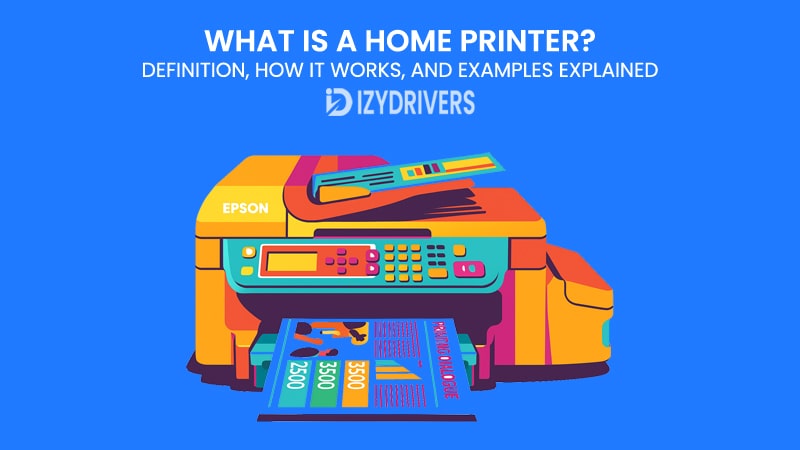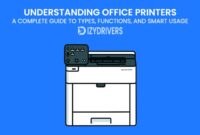In the past, printing documents was something we could only do at the office or a print shop. But today, with remote work, online learning, and even small home-based businesses becoming the norm, having a home printer has turned into more than just a convenience — it’s a necessity. From printing school assignments and invoices to creating shipping labels and family photos, a home printer quietly supports many parts of daily life.
Still, many people buy a printer without really understanding what it does or how it works. They often focus on the price or the brand name, then end up frustrated when ink runs out too fast, pages print too slowly, or Wi-Fi connections keep dropping. That’s why learning the basics of what a home printer truly is — including its definition, characteristics, and inner workings — can make a big difference in choosing the right one and using it efficiently.
A home printer isn’t just a smaller version of an office printer. It’s a device designed specifically for low to moderate printing needs, optimized for personal use and small households. Modern models now come with advanced features like wireless printing, mobile compatibility, and even eco-friendly ink systems that make home printing more cost-effective and sustainable.
In this guide, we’ll break down everything you need to know about home printers — from their meaning and key features to how they actually print text and images on paper. You’ll also find real-world examples and maintenance tips to help you keep your printer running smoothly. Whether you’re a student, remote worker, or small business owner, understanding your printer better means saving time, money, and frustration in the long run.
What Is a Home Printer?
A home printer is a compact printing device designed primarily for personal or small-scale use within a household environment. Unlike office printers that focus on high-volume, high-speed output, home printers emphasize convenience, affordability, and versatility. They cater to everyday printing needs such as homework, invoices, documents, crafts, or even family photos — all without leaving your desk.
At its core, a home printer converts digital files — text, images, or graphics — from your computer or smartphone into physical prints on paper. It acts as the bridge between the digital and physical world, transforming pixels into ink or toner patterns that bring your content to life.
The beauty of modern home printers lies in their accessibility. You don’t need to be a tech expert to use one. Most are plug-and-play devices, meaning you can set them up quickly through a USB or Wi-Fi connection, download the driver automatically, and start printing within minutes. In fact, many home printers today even support cloud printing, allowing you to print directly from Google Drive, Dropbox, or your phone — no cables required.
Home Printer vs. Office Printer
While both perform the same basic function — printing — they serve very different purposes.
Here’s how they typically compare:
| Feature | Home Printer | Office Printer |
|---|---|---|
| Printing Volume | Low to medium (up to 500 pages/month) | High (1,000+ pages/month) |
| Speed | Moderate (10–20 pages per minute) | Fast (30–60 pages per minute) |
| Cost | Affordable upfront | Expensive but cost-efficient per page |
| Size | Compact and lightweight | Larger, built for durability |
| Maintenance | Simple, user-friendly | Requires routine professional servicing |
| Connectivity | USB, Wi-Fi, mobile, cloud | Network and enterprise integration |
| Target User | Families, students, home offices | Companies, schools, shared workspaces |
A home printer’s smaller scale doesn’t mean it lacks sophistication. In fact, recent technological advances have blurred the line between personal and professional printer devices. Many all-in-one home printers now offer scanning, copying, and even faxing — features once exclusive to business-grade machines. The key difference lies in capacity and endurance, not necessarily in print quality.
Why Home Printers Matter Today
In a world increasingly dominated by digital documents, you might wonder — do we still need printers? The answer is yes, especially at home. There are still plenty of situations where having a printer nearby saves time and effort. Students need to submit printed assignments. Freelancers often need physical invoices or contracts. Parents print educational materials for their kids. Even small online businesses rely on home printers for product labels and receipts.
Another reason home printers remain relevant is personalization. Many people now use printers for creative hobbies — printing photos, stickers, planners, or custom artwork. Inkjet models with high color accuracy allow anyone to produce vibrant, professional-looking prints right at home.
Common Functions of a Home Printer
A typical home printer does more than just print documents. Here are the most common functions you’ll find:
- Printing: The core feature — from black-and-white documents to full-color graphics.
- Scanning: Convert physical documents or photos into digital files.
- Copying: Duplicate documents instantly without a computer.
- Wireless Printing: Send print jobs via Wi-Fi, Bluetooth, or mobile apps.
- Cloud Integration: Print directly from cloud storage like Google Drive or iCloud.
- Duplex Printing: Automatically print on both sides of a page to save paper.
These functions make home printers true multi-purpose tools, ideal for the evolving needs of modern households. Whether you’re a student, teacher, or remote worker, a reliable home printer is a small investment that delivers big value in flexibility and productivity.
Today’s home printers are smarter, more efficient, and more connected than ever. Manufacturers like HP, Canon, Epson, and Brother are continually innovating with eco-friendly ink systems, mobile printing apps, and AI-driven maintenance features that automatically detect and fix common errors. Some even support voice commands through smart assistants like Alexa or Google Home.
In short, a home printer isn’t just a gadget — it’s a home office essential that keeps up with the digital lifestyle. Understanding what it is and how it differs from office printers helps you make informed choices when it’s time to buy or upgrade your device.
Main Characteristics of a Home Printer
A home printer may look simple on the outside, but inside it’s a well-engineered device designed to balance performance, convenience, and cost. Understanding its main characteristics can help you choose the right printer that matches your daily needs and printing habits. Let’s explore the key aspects that define a typical home printer — from size and speed to ink type and connectivity.
1. Compact Size and User-Friendly Design
One of the first things you’ll notice about home printers is their compact and lightweight form. They’re made to fit comfortably on a small desk or shelf, ideal for homes with limited space. The design focus is on ease of use — minimal buttons, clear LED indicators, and often a simple touchscreen panel for navigation.
Unlike industrial printers that require technical setup, most home models are plug-and-play, meaning you can unbox, connect, and start printing in minutes. Manufacturers also pay attention to noise reduction, so your printer won’t disturb others during operation — an important factor for families and remote workers sharing space.
2. Moderate Print Speed
Home printers typically offer moderate printing speeds, balancing efficiency and print quality.
- Inkjet printers usually print between 8–15 pages per minute (ppm) for black-and-white documents and 5–10 ppm for color.
- Laser printers, on the other hand, can reach 20–30 ppm, making them ideal for users with heavier workloads.
While speed isn’t the top priority for home printers, it’s sufficient for day-to-day tasks like printing assignments, invoices, and letters.
3. Print Resolution and Output Quality
Resolution determines how sharp and detailed your prints appear. It’s measured in dots per inch (DPI).
Most home printers today offer:
- 600 × 600 DPI for basic documents
- 1200 × 1200 DPI or higher for detailed images and graphics
Inkjet models generally produce better color gradients and photo quality, while laser printers excel in crisp text and fine lines. Many modern devices also include photo printing modes to adjust color balance and contrast automatically.
4. Ink and Toner Systems
The type of ink system directly affects your printing cost and maintenance routine.
Here are the most common options:
| Type | Description | Pros | Cons |
|---|---|---|---|
| Ink Cartridge | Uses disposable cartridges for each color (Cyan, Magenta, Yellow, Black). | Easy to replace, widely available. | Higher cost per page. |
| Ink Tank (Refillable) | Uses built-in tanks you refill manually with bottled ink. | Lower running cost, eco-friendly. | Refilling can be messy if not careful. |
| Toner Cartridge | Used in laser printers; contains powdered ink (toner). | Fast, sharp prints, long-lasting. | Higher initial cost, bulky units. |
For most home users, ink tank printers (like Epson EcoTank or Canon MegaTank) have become increasingly popular because they significantly reduce the cost per page, making them ideal for frequent use.
5. Connectivity and Compatibility
Connectivity is one of the strongest features of modern home printers.
You can print from almost any device, including laptops, smartphones, and tablets, thanks to multiple connection options such as:
- USB – stable, direct connection for desktops or laptops.
- Wi-Fi / Wi-Fi Direct – print wirelessly from anywhere in your home.
- Bluetooth – quick printing from mobile devices.
- Cloud Printing – print directly from Google Drive, Dropbox, or iCloud.
- Mobile Apps – brand-specific apps like HP Smart, Canon PRINT, or Epson iPrint for enhanced control.
This flexibility lets you print instantly without cables, making the process smoother and more efficient — especially in homes with multiple users sharing one printer.
6. Power Efficiency and Running Costs
Home printers are designed to be energy-efficient, often featuring auto-sleep or eco mode that reduces power consumption when idle. But the true cost consideration lies in ink or toner expenses.
To evaluate total ownership cost, you can calculate the Cost Per Page (CPP) — the average ink cost to print one page.
For example:
- Cartridge-based inkjets: around Rp700–Rp1,200 per page
- Ink-tank printers: as low as Rp100–Rp200 per page
- Laser printers: roughly Rp300–Rp500 per page
This comparison helps users make smarter long-term decisions rather than focusing only on the upfront printer price.
7. Extra Features That Add Value
Modern home printers are more than just printing machines. Many models now include smart features that make printing more efficient and enjoyable, such as:
- Automatic Duplex Printing – saves paper by printing on both sides.
- Voice Printing Support – compatible with Alexa or Google Assistant.
- Built-in Memory Card Slot – print photos directly from SD cards.
- Borderless Photo Printing – perfect for crafting or photo albums.
- Touchscreen Control Panels – for intuitive navigation and setup.
These features might seem minor at first, but they collectively enhance the user experience and add genuine value for families and home offices alike.
8. Durability and Maintenance Simplicity
Because home printers are built for moderate use, they typically last 3–5 years with proper care. Maintenance is simple — replacing ink, cleaning the printhead occasionally, and keeping paper trays dust-free. Some newer models even include self-cleaning mechanisms that automatically prevent nozzle blockages, saving time and reducing waste.
Summary Table: Common Characteristics of Home Printers
| Feature | Typical Range / Example |
|---|---|
| Size | Compact (width < 45 cm) |
| Speed | 8–20 ppm (B/W) |
| Resolution | 600–1200 DPI |
| Ink System | Cartridge, Tank, or Toner |
| Connectivity | USB, Wi-Fi, Bluetooth, Cloud |
| Power Use | 10–30W (printing mode) |
| Lifespan | 3–5 years (average) |
A home printer is all about balance — not too big, not too fast, but perfectly optimized for personal use. Once you understand these characteristics, you can better assess which printer fits your lifestyle, whether you print occasionally or every day.
How Does a Home Printer Work?
Understanding a home printer is one thing, but knowing how it actually works takes your knowledge to the next level. Printers may look simple from the outside, but inside, they perform a series of precise actions to transfer digital information into physical prints. Let’s explore the mechanisms behind the most common types of home printers: inkjet, laser, and wireless smart printers.
Basic Printing Mechanism
At its core, printing begins with digital data from your computer or mobile device. When you hit the “Print” button:
- Document Processing: The printer driver converts your file into a language the printer can understand, translating text and images into raster graphics or printer commands.
- Data Transmission: Depending on your connection (USB, Wi-Fi, or cloud), the printer receives the processed data.
- Image Formation: Inside the printer, this data directs the movement of printheads, laser beams, or toner to reproduce the content on paper.
- Paper Handling: The paper feeder moves each sheet precisely while the print mechanism deposits ink or toner.
- Final Output: The printed page emerges, ready to use.
Even though these steps happen in seconds, they rely on highly coordinated mechanical and digital systems.
Inkjet Printer Working Principle
Inkjet printers are the most common type for home use due to their affordable price and excellent color quality. Here’s how they work:
- Nozzle Operation: Tiny nozzles spray micro-drops of liquid ink directly onto paper.
- Printhead Movement: The printhead moves back and forth across the page, layer by layer.
- Ink Absorption: Paper fibers absorb the ink as it’s deposited, forming precise shapes and colors.
- Color Mixing: Different nozzles for Cyan, Magenta, Yellow, and Black mix in varying proportions to produce full-color prints.
Some advanced inkjet models use thermal or piezoelectric technology to control droplet size and placement, ensuring sharper images and smoother gradients.
Pros: High-quality photos, smooth color transitions, compact design.
Cons: Slower speed and higher ink cost per page compared to laser printers.
Laser Printer Working Principle
Laser printers are typically faster and better suited for text-heavy documents. They operate using a combination of laser, drum, and toner:
- Electrostatic Charging: The drum (a cylindrical component) is electrically charged.
- Laser Scanning: A laser beam selectively discharges areas of the drum corresponding to the image or text to print.
- Toner Attraction: Toner particles, which are electrically charged, stick only to the discharged areas.
- Transfer to Paper: Paper passes over the drum, picking up the toner particles.
- Fusing: Heat and pressure from the fuser unit melt the toner onto the paper, creating a permanent image.
Pros: Fast printing, crisp text, and long-lasting toner.
Cons: Higher initial cost, bulkier devices, not ideal for high-quality photo prints.
Wireless and Smart Printing
Modern home printers often support wireless printing, cloud integration, and mobile app control:
- Wi-Fi Printing: The printer connects to your home network. Devices on the same network can send print jobs without physical cables.
- Bluetooth Printing: Quick and direct connection to mobile devices.
- Cloud Printing: Upload documents to cloud storage (e.g., Google Drive) and print remotely.
- Mobile Apps: Brand-specific apps allow scanning, monitoring ink levels, duplex printing, and scheduling print jobs.
These smart features make printing more flexible and convenient, allowing multiple users to share a single home printer seamlessly.
Print Quality Factors
Whether you’re using inkjet or laser, several factors affect output quality:
- Resolution (DPI): Higher dots per inch mean sharper images.
- Paper Type: Glossy, matte, or plain paper changes ink absorption and color vibrancy.
- Ink/Toner Quality: Original cartridges generally produce better results than third-party alternatives.
- Maintenance: Regular cleaning of printheads or toner drums prevents streaks and smudges.
Behind the Scenes: Automation and Efficiency
Home printers are designed for effortless operation:
- Automatic paper feeding reduces manual handling.
- Sensors detect paper jams and alert users instantly.
- Some models include self-cleaning nozzles to prevent clogging.
- Duplex printing saves paper without manual intervention.
These automated mechanisms ensure users get high-quality prints with minimal effort — even if you’re not technically inclined.
Types of Home Printers
Choosing a home printer isn’t just about picking a device that prints; it’s about understanding which type best suits your needs. Home printers generally fall into a few main categories — each with distinct features, advantages, and ideal use cases. Knowing the differences can save you money, time, and frustration.
1. Inkjet Printers
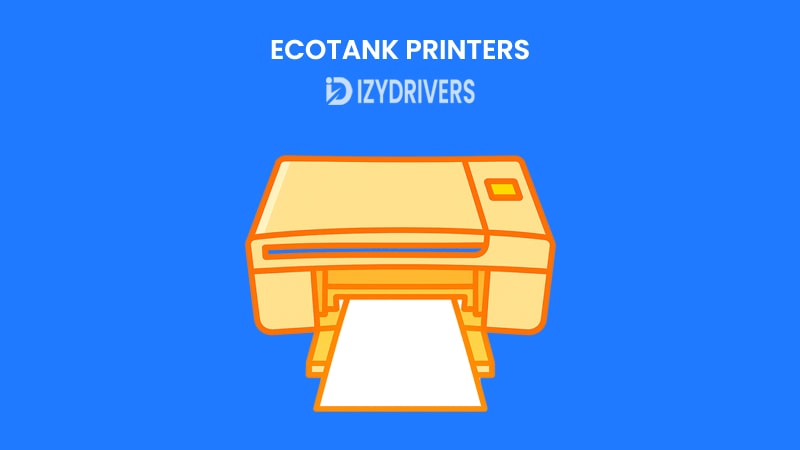
Inkjet printers are the most popular choice for home users. They spray tiny droplets of liquid ink directly onto paper, producing high-quality images and text.
Key characteristics:
- Excellent color quality and photo printing.
- Compact and lightweight design.
- Moderate speed (8–15 pages per minute for black-and-white, 5–10 ppm for color).
Ideal for: Students, families, and hobbyists who print documents, photos, or creative projects occasionally.
Example models:
- Canon PIXMA series
- Epson EcoTank series
- HP DeskJet series
Pros: High-quality prints, easy to use, affordable upfront cost.
Cons: Ink can be expensive, slower for high-volume printing.
2. Laser Printers
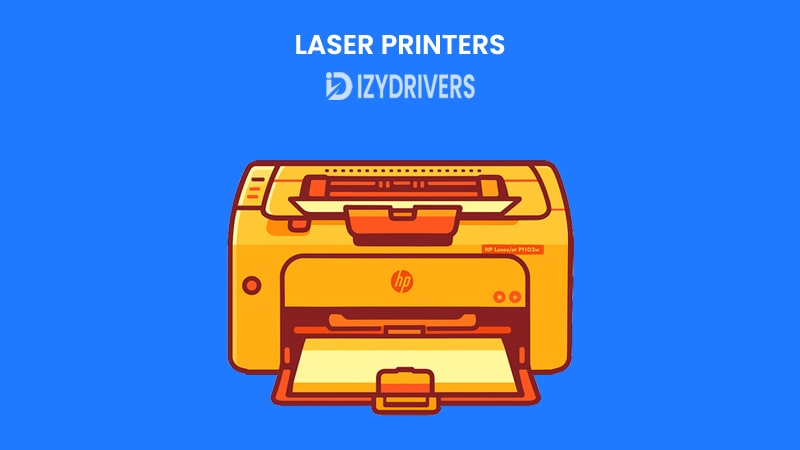
Laser printers use a laser beam to transfer toner onto paper. They excel at producing crisp text quickly and are built for efficiency and reliability.
Key characteristics:
- Fast printing speed (20–30 pages per minute).
- Sharp, high-resolution black-and-white text.
- Toner lasts longer than ink cartridges.
Ideal for: Home offices or users with heavier printing demands, especially text documents.
Example models:
- Brother HL-L2350DW
- HP LaserJet Pro series
Pros: Fast, low cost per page, durable.
Cons: Larger size, more expensive upfront, color printing is limited or costly.
3. All-in-One Printers
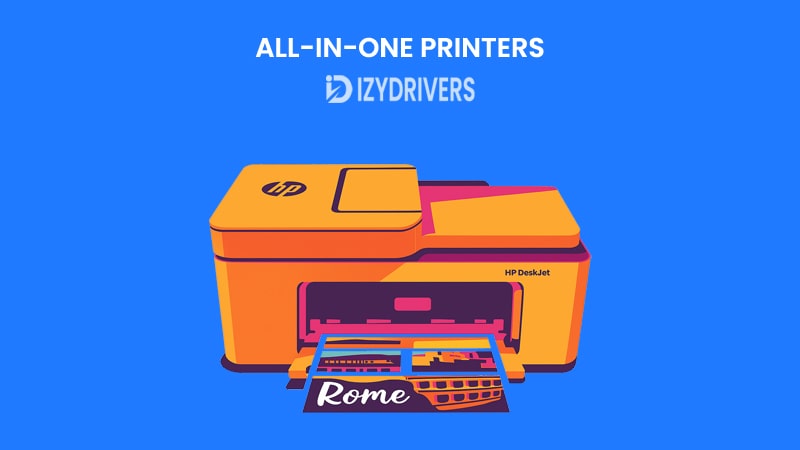
All-in-one Printers also known as multifunction printers (MFPs), all-in-one devices combine printing, scanning, copying, and sometimes faxing in a single machine. Both inkjet and laser versions are available.
Key characteristics:
- Versatile and space-saving.
- Suitable for multiple tasks beyond printing.
- Often include wireless connectivity and mobile app support.
Ideal for: Families, small home offices, and students who need scanning and copying in addition to printing.
Example models:
- Canon PIXMA TS series
- Epson EcoTank ET series
- HP Envy All-in-One series
Pros: Saves space and cost, convenient.
Cons: Slower than single-function printers for high-volume printing, slightly higher maintenance.
4. Photo Printers
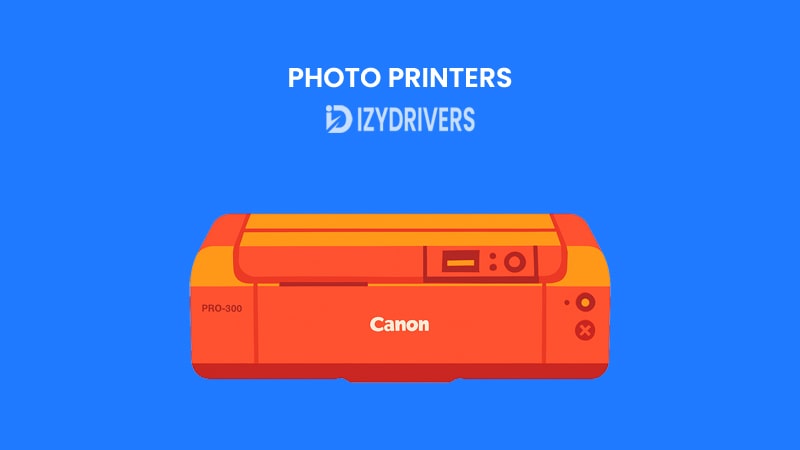
Photo printers are specialized inkjet printers designed for high-quality image printing, often supporting borderless photos and advanced color calibration.
Key characteristics:
- High resolution (up to 4800 DPI or more).
- Vibrant, detailed prints suitable for framing or creative projects.
- Uses specialized printer photo paper for optimal results.
Ideal for: Photography enthusiasts, scrapbookers, or families printing vacation photos.
Example models:
- Canon SELPHY series
- Epson PictureMate series
Pros: Stunning photo quality, compact for personal use.
Cons: Limited functionality for text-heavy documents, slower speed, higher cost per photo.
5. EcoTank / Refillable Ink Printers
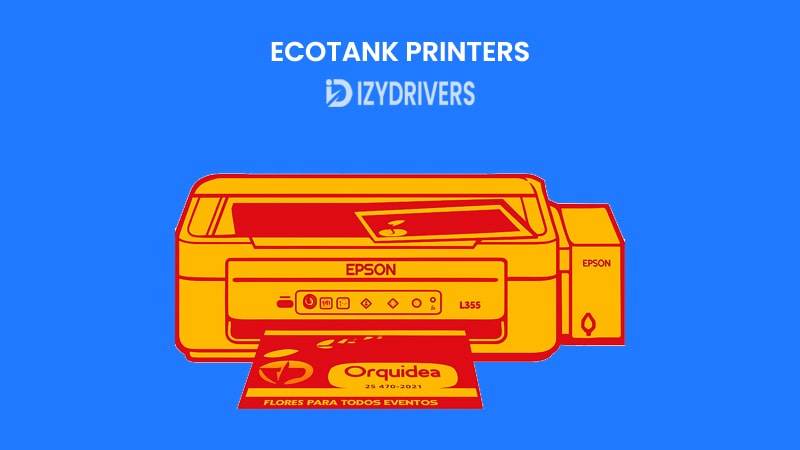
EcoTank printers feature refillable ink tanks instead of cartridges, which drastically reduces the cost per page and environmental waste.
Key characteristics:
- Large ink reservoirs refillable with bottles.
- Extremely low cost per page.
- High-capacity printing before refilling.
Ideal for: Frequent home printers, students printing assignments, or home businesses with moderate print volumes.
Example models:
- Epson EcoTank L3150
- Canon MegaTank G series
Pros: Cost-efficient, eco-friendly, long-lasting ink supply.
Cons: Higher upfront cost, refilling requires care to avoid spills.
Summary Table: Home Printer Types With Pros & Cons
| Printer Type | Ideal Use | Pros | Cons | Example Models |
|---|---|---|---|---|
| Inkjet | Documents, photos, crafts | High-quality prints, compact | Expensive ink, slower | Canon PIXMA, Epson EcoTank |
| Laser | Text-heavy, fast printing | Fast, low cost/page | Large, costly color printing | Brother HL-L2350DW, HP LaserJet Pro |
| All-in-One | Printing + scanning/copying | Versatile, space-saving | Slower for high volume | Canon PIXMA TS, HP Envy All-in-One |
| Photo Printer | High-quality images | Vibrant photos | Limited text use, slower | Canon SELPHY, Epson PictureMate |
| EcoTank / Refillable | Frequent printing, home business | Low cost/page, eco-friendly | Higher upfront cost | Epson EcoTank L3150, Canon MegaTank G |
Selecting the right type of printer for home use depends on your printing volume, primary use, and budget. For example, an inkjet or photo printer is perfect for occasional color printing and creative projects, while a laser printer or EcoTank model works best for frequent, text-heavy printing at home.
Real-Life Examples and Use Cases
Owning a home printer is no longer just a convenience—it’s become an essential tool for everyday life. Whether for students, families, or small business owners, printers serve a variety of purposes that go beyond simply producing documents. Let’s explore some real-world examples to understand how home printers fit seamlessly into daily routines.
1. Students and Homework Printing
For students of all ages, printing homework, essays, and project reports is often necessary. While many assignments are submitted digitally, teachers still require printed versions for exams, portfolios, or classroom presentations. A home printer allows students to:
- Print essays and worksheets without leaving home.
- Create visually appealing projects with color charts, images, and graphs.
- Save time by printing multiple copies for group assignments.
Example: A high school student uses an Epson EcoTank inkjet printer to print weekly assignments and creative projects, taking advantage of the low-cost refillable ink for frequent printing.
2. Remote Work and Home Offices
With remote work on the rise, home printers have become indispensable for professionals. Printing contracts, invoices, proposals, and reports is often faster and more reliable than relying on office facilities or local print shops. Key benefits include:
- Immediate printing of important documents.
- Scanning and emailing documents directly from the printer.
- Copying physical documents for records.
Example: A freelance designer uses a Canon PIXMA all-in-one printer to print client contracts, scan signed agreements, and copy reference materials without leaving the house.
3. Small Business and Home-Based Enterprises
Entrepreneurs running small online businesses can also benefit from home printers. Labels, receipts, invoices, and marketing materials are often needed on-demand. Features like wireless printing, duplex printing, and high-capacity ink tanks make operations smoother.
Example: An Etsy shop owner prints shipping labels and invoices using a Brother laser printer, saving time and reducing the cost of outsourcing printing tasks. The printer’s fast speed and toner efficiency make it ideal for managing moderate daily printing volumes.
4. Personal and Creative Projects
Home printers are not limited to practical documents—they also support personal hobbies and creative projects:
- Printing family photos or photo albums.
- Creating greeting cards, calendars, or scrapbooks.
- Printing custom planners, stickers, or decorative items.
Example: A parent prints weekly educational worksheets and coloring pages for their children using a Canon SELPHY photo printer, allowing them to mix learning and fun at home.
5. Educational and Organizational Uses at Home
In addition to personal and professional purposes, home printers help maintain organization and productivity:
- Printing calendars, schedules, and checklists.
- Producing labels for home storage or pantry items.
- Printing recipes, study guides, or DIY instructions.
Example: A family uses an Epson EcoTank printer to print weekly meal plans, grocery lists, and chore charts, keeping their household organized efficiently.
These real-life cases highlight a critical point: the value of a home printer is not just in the device itself but in how it fits into your daily life. Understanding different scenarios helps buyers select the right printer type, features, and connectivity options that suit their specific needs.
Key takeaways:
- Students benefit from quality printing for assignments and creative projects.
- Remote workers need fast, reliable, and multifunctional printers for documents and scanning.
- Small business owners rely on speed, efficiency, and cost-effectiveness.
- Families and hobbyists appreciate creative printing and home organization.
By recognizing these use cases, you can make an informed decision when choosing a home printer and ensure it delivers both convenience and value.
Conclusion
A home printer is more than just a device for printing documents — it is a versatile tool that supports everyday life, whether you are a student, a remote worker, a small business owner, or a creative hobbyist. From understanding the definition and main characteristics, to learning how it works, and exploring real-life examples, it is clear that choosing the right home printer requires knowledge of your specific needs and usage patterns.
Modern home printers come in various types, including inkjet, laser, all-in-one, photo, and EcoTank models, each designed to balance performance, cost, and convenience. Equipped with smart features such as wireless printing, mobile app support, and automatic duplex printing, these printers make life at home more productive and efficient.
Maintaining your printer properly and understanding basic troubleshooting techniques ensures that it performs optimally for years. With a reliable home printer, you can save time, reduce costs, and even enjoy creative projects — all without stepping out of your house.
FAQs About Home Printer
What is the difference between a home printer and an office printer?
Home printers are designed for low to moderate printing volumes, focusing on compact design, ease of use, and versatility. Office printers handle high-volume printing, faster speeds, and often include enterprise-level features.
Which type of home printer is best for daily use?
Inkjet or EcoTank printers are ideal for everyday home use due to their affordability, photo-quality output, and low-cost refillable ink options. Laser printers are better for text-heavy or high-volume needs.
How long does a home printer typically last?
With proper care, most home printers last 3–5 years. Regular maintenance, such as cleaning printheads and replacing cartridges or toner on time, helps extend their lifespan.
Can I use a home printer for business printing?
Yes, especially for small-scale operations like home-based businesses. Choose a printer that supports higher print volumes, wireless connectivity, and cost-effective ink or toner systems.
How can I reduce ink or toner costs at home?
Use refillable EcoTank or high-yield toner cartridges, print in draft mode for non-essential documents, and avoid unnecessary color printing. Regular maintenance also prevents waste from clogs or misprints.

